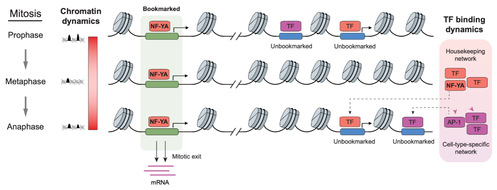USTC revealed the dynamic and regulatory blueprint of mitotic bookmarking
A team led by Prof. QU Kun from the University of Science and Technology (USTC) of the Chinese Academy of Sciences (CAS) in collaboration with a team led by Prof. WANG Zhikai from the Hefei National Laboratory for Physical Sciences at the Microscale (HFNL) revealed a dynamic and regulatory map of chromatin accessibility that reveals important bookmarking factors. The result was published in Science Advances.
Mitosis is accompanied by changes in histone, the loss of chromatin accessibility and the silencing of gene transcription. However, there are emerging observations indicating that some chromatin features are partially or completely preserved during mitosis, conveying gene regulatory architectures like “bookmarks”, which is known as “mitotic bookmarking”. The structural and functional states of active genes could be bookmarked to ensure their proper reactivation after mitosis, which is essential for the transmission of transcriptional memory from mother cells to daughter progenies.
In the study, researchers used the plate-based single-cell transposase accessible chromatin sequencing (scATAC-seq) technique to analyze 6538 mitotic cells and characterize the dynamics of chromatin accessibility during mitosis. Using pseudotime inference anaylsis, they got a two-dimensional map of the chromatin accessibility of the cells and found that chromatin accessibility continued to decrease after mitotic entry and then began to increase at the metaphase-anaphase transition. Based on the map, they found a subset of chromatin regions that remained open throughout mitosis and defined it as “bookmarked regions”. These regions were enriched in promoters of genes that were rapidly reactivated after mitosis.
As open chromatin is often occupied by transcription factors (TFs), the researchers investigated which TFs exert potential regulatory functions after metaphase. Using TF binding motif enrichment analysis, they found that the nuclear transcription factor Y subunit α(NF-YA) motif CCAAT is the most enriched motif in these regions. They further demonstrated that NF-YA functioned as a bookmarking TF by preferentially occupying the bookmarked regions, and NF-YA knockdown (KD) impaired chromatin accessibility expansion and transcriptional reactivation upon mitotic exit. They confirmed the bookmarking role of NF-YA by performing a depleting experiment, whose result is consistent with the conclusion.

The dynamic and regulatory blueprint (Image by QU Kun et al.)
(Written by WENG Guchen, edited by TONG Xinyang, USTC News Center)
Back
